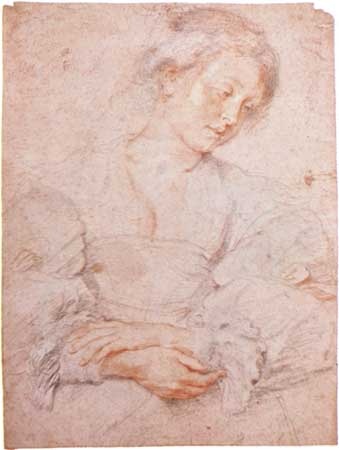chalk drawing
art
 in the visual arts, technique of drawing with chalk, a prepared natural stone or earth substance that is usually available in black (made either from soft black stone or from a composition including lampblack), white (made from various types of limestone), and red, or sanguine (made from red earths such as red ochre). The earliest chalk drawings date from Paleolithic times.
in the visual arts, technique of drawing with chalk, a prepared natural stone or earth substance that is usually available in black (made either from soft black stone or from a composition including lampblack), white (made from various types of limestone), and red, or sanguine (made from red earths such as red ochre). The earliest chalk drawings date from Paleolithic times.This technique has been favoured primarily as a medium for making quick preliminary sketches, occasionally for roughing in the background of a larger work, and increasingly since the late Renaissance as a medium in its own right for finished drawings. In the 16th and 17th centuries, Peter Paul Rubens (Rubens, Peter Paul) and other artists often combined black and white chalk, a technique known as aux deux crayons. As developed by Rococo (Rococo style) artists such as Antoine Watteau (Watteau, Antoine) and François Boucher (Boucher, François), the expressive range of chalk drawings grew as broad as that of watercolours or pastels. The devices employed in the 18th century to achieve this subtlety of effect included the use of coloured paper; combining red, black, and white chalk (a technique known as aux trois crayons); and manipulating the medium to create an effect of mass rather than of line. In the 20th century, chalk was principally used by artists adhering to traditional art styles but also by such avant-garde painters as Henri Matisse (Matisse, Henri), Pablo Picasso (Picasso, Pablo), and Willem de Kooning (de Kooning, Willem). See also sanguine.
- Cornell, Joseph
- Cornell, Katharine
- Cornell University
- Cornel West
- Cornel Wilde
- Corner Brook
- cornerstone
- cornet
- cornetfish
- cornett
- Cornford, Frances
- Cornforth, Sir John
- corn harvester
- cornice
- Corning
- Cornish language
- Cornish literature
- Cornish wrestling
- Corn Islands
- Corn Law
- Corn Mother
- corn oil
- Cornplanter
- corn poppy
- corn salad